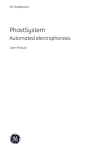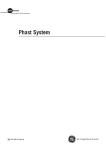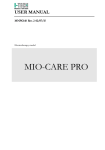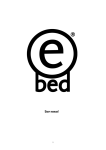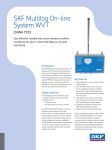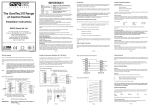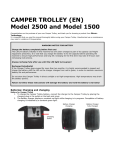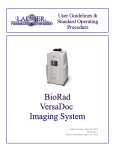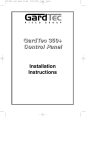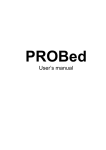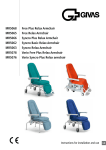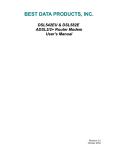Download PhastSystemTM Development Unit
Transcript
A M E R S H A M B I O S C I E N C E S PhastSystem Development Unit TM User Manual 18-1060-96 Edition AB Important user information Reading this entire manual is recommended for full understanding of the use of this product. The exclamation mark within an equilateral triangle is intended to alert the user to the presence of important operating and maintenance instructions in the literature accompanying the instrument. Should you have any comments on this manual, we will be pleased to receive them at: Amersham Biosciences AB S-751 82 Uppsala Sweden Amersham Biosciences AB reserves the right to make changes in the specifications without prior notice. Warranty and Liability Amersham Biosciences AB guarantees that the product delivered has been thoroughly tested to ensure that it meets its published specifications. The warranty included in the conditions of delivery is valid only if the product has been installed and used according to the instructions supplied by Amersham Biosciences AB. Amersham Biosciences AB shall in no event be liable for incidental or consequential damages, including without limitation, lost profits, loss of income, loss of business opportunities, loss of use and other related exposures, however caused, arising from the faulty and incorrect use of the product. Trade marks PhastSystem ™ and PhastGel® are the exclusive trade marks of Amersham Biosciences AB. In view of the risk of trade mark degeneration, it is respectfully suggested that authors wishing to use these designations refer to their trade mark status at least once in each article. © Copyright 1995 Amersham Biosciences AB All rights reserved. No part of this publication may be reproduced, stored in a retrieval system or transmitted in any form or by any means, without permission in written form from the company. Contents 1. Introduction . . . . . . . . . . . . . . . . . . . . . . . . . . . . . . . . . . . . . . . . . . 3 2. Important Safety Information . . . . . . . . . . . . . . . . . . . . . . . . . 3 2.1 Safety precautions . . . . . . . . . . . . . . . . . . . . . . . . . . . . . . 3 3. Description of PhastSystem Development unit . . . . . . . . . . 4 3.1 Description . . . . . . . . . . . . . . . . . . . . . . . . . . . . . . . . . . . . 4 3.2 Chemical resistence . . . . . . . . . . . . . . . . . . . . . . . . . . . . . 5 4. Installation . . . . . . . . . . . . . . . . . . . . . . . . . . . . . . . . . . . . . . . . . 7 4.1 Unpacking . . . . . . . . . . . . . . . . . . . . . . . . . . . . . . . . . . . . .7 4.2 Mains connection . . . . . . . . . . . . . . . . . . . . . . . . . . . . . . . 7 4.3 Turning the systems on. . . . . . . . . . . . . . . . . . . . . . . . . . 9 4.4 Before use . . . . . . . . . . . . . . . . . . . . . . . . . . . . . . . . . . . . . 9 5. Operation . . . . . . . . . . . . . . . . . . . . . . . . . . . . . . . . . . . . . . . . . . . 10 5.1 Preparing the development unit . . . . . . . . . . . . . . . . . 10 6. Maintenance . . . . . . . . . . . . . . . . . . . . . . . . . . . . . . . . . . . . . . . . . 12 7. Ordering and technical information . . . . . . . . . . . . . . . . . . . . .15 7.1 Ordering information . . . . . . . . . . . . . . . . . . . . . . . . . . . 15 7.1.1 PhastSystem and accessories . . . . . . . . . . . . . . . . . . . .15 7.1.2 Spare parts . . . . . . . . . . . . . . . . . . . . . . . . . . . . . . . . . . . 16 7.1.3 PhastGel media and accessories . . . . . . . . . . . . . . . . . 17 7.2 Technical information . . . . . . . . . . . . . . . . . . . . . . . . . . 18 7.2.1 Development unit . . . . . . . . . . . . . . . . . . . . . . . . . . . . . 18 7.2.2 Common data . . . . . . . . . . . . . . . . . . . . . . . . . . . . . . . . 18 1. Introduction 1. Introduction PhastSystem™ consists of a separation and control unit, a development unit, pre-cast PhastGel® separation media, accessories, and a technical support package. These components work together to form a system for fast, highresolution, and reproducible electrophoresis. PhastSystem development unit is controlled from PhastSystem separation and control unit. The schematic diagram below illustrates the steps involved in producing a finished electrophoresis gel using PhastSystem with PhastGel separation media. 3 2. Important safety information 2. Important safety information 2.1 Safety precautions In keeping with good laboratory practice, we advise you to take the following precautions when dealing with the instrument. 1. Regularly check all insulation cables, take care not to damage the units, especially the separation compartment’s lid. Note: For full safety it is important that the lid is not tampered with. 4 2. Ensure that the mains cables are plugged into fully grounded mains outlets. 3. Check on the rear panel at the instrument that the correct voltage is printed on the back and that the voltage selector setting is in accordance with your local electricity supply. (See section 4.2 Mains connection). 4. Allow only authorised service representatives to service or work on the electrical circuitry of PhastSystem. 5. Avoid spilling buffers or other conducting liquids onto the instrument. 3. Description of the development unit 3. Description of PhastSystem Development unit 3.1 Description The visible parts of the development unit are: a stainless steel chamber (with a heating foil), a rotating gel holder for one or two gels, a temperature and level sensor on the underside of the lid, and ten ports through which the development chamber can be filled and emptied. Ports labelled 1-9 are used to connect development solutions to the development chamber. The port labelled 0 is reserved for waste, that is, solutions only exit through this port. The gel holder, liquid level sensor, and temperature sensor are mounted in the lid of the development chamber and protrude into the chamber when the lid is closed. Inside the unit there is a pneumatic pump for filling and emptying the chamber, a 10-port valve for the selection of ports, and a 3-port valve for the selection of pump functions i.e., creating vacuum or pressure in the chamber. The pneumatic pump is connected to an opening in the lid of the chamber. A gasket in the lid makes the chamber airtight when the lid is closed. By creating a vacuum in the chamber, liquid is drawn in through a hole in the bottom of the chamber. Similarly, by creating excess pressure in the chamber, liquid is pushed out through the same hole in the bottom. Fig. 1. Development chamber 5 3. Description of the development unit Cap-set Tube markers 10-Port valve Fig. 2. 10-port valve 3.2 Chemical resistance The parts that come into contact with development solutions in the development unit are resistant to chemicals typically used in Coomassie and silver staining, for example acetic acid, methanol, and silver staining solutions. If you plan to use other chemicals, for example, to clean the unit, you should first check the resistance of the wetted parts to the chemical in question. The chemical resistance of a polymer depends on many factors, including the temperature and concentration of the solution, the application (a compound that swells may function well as a static seal, yet fail in dynamic applications), and the period of exposure. Table 1 below is intended as a general guide for the chemical resistance of the wetted parts in the development unit. If you are in doubt about the resistance of wetted parts to a certain chemical, test the parts first; order spare sparts for such tests (see Ordering information, chapter 7. In general you should avoid using ketones, hot strong acids, and organic hydrocarbons. 6 3. Description of the system Table 1 : A general guide for the chemical resistance of the wetted parts in the development unit. Wetted parts1 Material of construction Generally resistant to Generally attacked by Distributor and distributing plate PVDF2 PVDF2 strong acids and bases in moderate concentration and alcohols and hydrocarbons ketones, esters, and hot acids Gasket (10-port valve) fluoro rubber moderate acids, strong bases, many solvents, alcohols, aldehydes hot stroch acids, esters, ketones, and bleach Tubing (10-port to chamber) Teflon most chemicals extreme conditions Tubing (bottles to 10-port valve PVC3 hot acids, ketones, and strong acids and hydrocarbons bases in moderate concentration, alcohols, aldehydes, and bleach Chamber, gel holder, and temp. sensor stainless steel most chemicals long exposure to salt solutions Chamber lid gasket EPDM4 stroch acids and bases, alcohols, aldehydes, and ketones hot acids and aromatic hydrocarbons Chamber lid PP5 hot stroch acids strong acids in moderate conaromatic hydrocarbons, and centration, stroch bleach bases in high concentration, alcohols, aldehydes, and ketones 1 4 2 5 These parts are illustrated in Fig. 1, 2, 6 and 7. Polyvinylidine fluoride 3 Polyvinyl chloride Ethylene propylene copolymer and terpolymer Polypropylene (or polypropene) 7 4. Installation 4. Installation Important! 4.1 Unpacking The following information must be read to install your PhastSystem instruments correctly. Unpack the equipment carefully and check the contents of the carton against the packing list. Save the packing material and the carton in case PhastSystem must be returned. Check the equipment for any visible signs of damage that may have occurred during shipment. Removal of locking screw Remove the locking screw on the left of the underside of the development unit. The air pump is mounted on a rubber support and fixed with this screw during shipment. Save the locking screw in case you should ever need to ship the unit. (Leaving the screw in place will make the unit noisier but will not affect the operation.) 4.2 Mains connection Voltage selector setting The instruments are available in two versions: one for 220-230/240 V AC, referred here to as the 220 V model, and one for 100/120 V AC, referred here to as the 120 V model, electricity supplies. Check that the instruments have the correct voltage and code number printed on their back panel. Set the voltage selectors on the rear panel of the separation and control unit and development unit according to your local electricity supply; 100/120 V, or 220-230/240 V. To do this: ● ● 8 Check the voltage range of the mains electricity supply. Set the voltage selector to the appropriate setting according to the table below. Voltage range Voltage selector setting For (120 V model) instruments: 90-110 108-132 100 120 For (220 V model) instruments: 198-244 216-264 220-230 240 4. Installation Fuses Each unit has two fuses. Check that the fuses are correctly installed and intact. Connecting the units Connect the separation and control unit to the development unit with the communication cable (code no. 19-6005-02). The PhastSystem Development Unit is to be used exclusively with the PhastSystem Separation Unit. Voltage selector communication cable To mains on/off To mains Voltage selector Fig. 3. PhastSystem controls rear. Mains connection Plug the mains power cords into the input marked MAINS on the rear panel of the units. Plug the cords into the wall outlet (grounded to earth). Important! Always disconnect these cords when service the instruments. 9 4. Installation 4.3 Turning the system on The PhastSystem development unit is controlled from the PhastSystem separation and control unit. The system is turned on by pressing in the on/off button on the rear panel of the separation and control unit. The development unit is automatically activated when a development method is started. Temperature sensor A temperature sensor is placed on the underside of the lid in the development chamber (enclosed in stainless steel). The temperature sensor is calibrated before shipment, but you may want to check and calibrate it before use. See PhastSystem User Manual, the chapter on Maintenance, for instructions. 4.4 Before use Before using the development unit we recommend that you run a cleaning method to remove dust accumulated during storage and shipment. A cleaning method requires only distilled water and the level sensor shield (instead of gels). The level sensor shield is in the gel holder in the development chamber when you receive PhastSystem. For instructions see PhastSystem Users Manual, the section on cleaning method. The level sensor shield must remain in the chamber when running methods without gels; otherwise, the chamber will not fill. Warning! The level sensor (on the underside of the development chamber lid) is enclosed in glass and is quite fragile. Use extreme care when cleaning this sensor. 10 5. Operation 5. Operation The procedure for running development methods comprises four steps: making up the solutions, connecting the bottles to the correct ports with the PVC tubing, inserting the gels and pressing the start key. The rest is automatic. 5.1 Preparing the development unit You should always keep a fresh stock of solutions. Filter solutions to keep the channels in the development unit clear and to avoid precipitation on the gel(s). We recommend that you label the bottles and the tubing (use the yellow tubing markers to mark the tubes) with their corresponding port number. 1. Remove the caps on the cap set from the ports that you plan to use. 2. Connect the ports (l-9) as required to the solution bottles with PVC tubing. 3. Connect port 0 to waste: Use an empty bottle. 4. Check for kinks in the tubing. Make sure that tubing is securely submerged in the solutions. Important ! The chamber fills with approximately 70 ml of solution. The bottles should be filled with at least 75 to 80 ml of solution to allow for the residual solution in the tubing. 5. Open the lid of the development chamber by pressing on the right end of the red bar. 6. Check that the chamber gasket (on the lid) is secure. Inserting the gels 7. Remove one gel from the separation bed with a pair of forceps (use the tab of the gel backing). Be careful not to touch the gel surface with your fingers since fingerprints stain and cloud the protein bands. 8. Slide the gel, gel surface down, into the upper position of the gel holder. Remove the other gel and slide it, gel surface up, into the lower position of the gel holder. Note! If you are developing only one gel, slide it into the lower position, gel surface up. 11 5. Operation Fig. 4. Inserting the gel into the gel holder. 9. Close the lid and lock it by simultaneously pressing down on the top of the lid and pushing in the red bar. Fig. 5. Closing the development chamber lid. 12 6. Maintenance 6. Maintenance The maintenance required by the operator concerns the gasket in the lid, the gasket in the 10-port valve, and the tubing between the 10-port valve and the chamber. The gasket in the lid should be replaced when visibly damaged, when filling and emptying takes longer than usual or when filling and emptying does not function properly (the chamber must be airtight for filling and emptying). The other two items should be replaced if they start to leak. Replacing the lid gasket Just pull the gasket off. Be sure to turn the recess in the new gasket outwards. Replacing the 10-port valve gasket Opening the valve 1. Start the development run (any method) but press “DEV pause/ continue” as soon as EMPTYING P0 appears on the display. When the 10-port valve is in position P0, the channel (groove) in the channel plate is always pointing to 12 o’clock. 2. Disconnect the development unit mains power cable. 3. Raise the valve end of the unit about 30°. (Do not stand the unit on end or residual liquid may enter delicate parts in the unit. ) 4. Unscrew the pressure plate, taking a few turns at a time on each screw. 5. Remove the distributor and distributing plate, see figure. Closing the valve 6. Without touching the surface of the distributing plate, place the gasket against the smooth side, with the notch in the gasket against the notch in distributing plate. 7. Place the two parts into the distributor. 8. Reassemble the valve. Remember the channel (groove) in the channel plate should be pointing to 12 o’clock. (The valve will not connect ports as programmed if the channel plate is turned by o 180 .) 9. Make sure the u-shaped metal piece is sitting under the valve and that the hole for the screw is to the right. Insert the screws in the pressure plate. Screw in the left and right screws first a few turns, then the bottom screw and finally the top screw. Tighten the left and right screws securely and the top and bottom screws just until there is resistance. 10. Re-connect mains power cable. Press “DEV pause/continue” and then “DEV start/stop”. 13 6. Maintenance If the valve leaks, open and check that all parts are correctly mounted. Note: If the valve still leaks, you may have to replace the distributing and channel plates also. The 10-port valve Fig. 6. The 10-port valve. The 10-port valve to chamber tube Fig. 7. The 10-port valve to chamber tube. 14 6. Maintenance Replacing the valve to chamber tubing Disconnect the power cable. Let the unit rest on the end opposite to the 10-port valve. Remove the clamp at the valve end first and disconnect the tubing from the valve. Remove the black cover plate for the tubing using a Philips screwdriver. Shake the tubing to remove residual liquid. Then remove the clamp at the chamber end. (Do not remove this clamp first, residual liquid might then enter the unit.) Make sure that the new tubing rests in the recession when you put the cover back. Cleaning Wipe the instrument regularly with a damp cloth. Please be extra careful with the glass level sensor. Let the instrument dry completely before use. Servicing All service, except the above described, should be entrusted to qualified personnel only. Please contact your local Amersham Biosciences representative for more service information. 15 7. Ordering information and technical data 7. Ordering and technical information 7.1 Ordering information 7.1.1 PhastSystem and accessories Designation Quantity Code no. 18-1018-23 Separation-Control and Development Unit (120 V) Separation-Control and Development Unit (220 V) 18-1018-24 Separation-Controll Unit (120V) 18-1200-00 Separation-Controll Unit (220V) 18-1200-10 Development Unit (120V) 18-1200-20 Development Unit (220V) 18-1200-30 PhastTransfer Includes gel backing remover 18-1001-23 Accessories PhastGel Sample Applicators 12/0.3 µl 50 18-1614-01 8/0.5 µl 50 18-1617-01 8/1 µl 50 18-1618-01 6/4 µl 50 18-0012-29 Titration curve 50 18-1657-01 Sample well stamp 1 18-0079-01 200 18-1003-18 PhastTransfer filter paper (50x50 mm) 16 7. Ordering information and technical data 7.1.2 Spare parts This is a list of spare parts that might be required when following the maintenance outlined in Chapter 6. A complete spare parts list is contained in the service manual. Designation Quantity Code no. Gasket (dev. chamber) 1 18-0048-01 Gasket (l0-port valve) 1 18-9482-01 Cap set (l0-port valve) 1 18-0072-01 Valve kit (l0-port valve) (includes: distributing plate and channel plate) 1 18-1019-61 Distributor (10-port valve) 1 18-0029-01 Tubing PVC (5 meters) 1 19-0182-01 Tubing kit (10-port valve to chamber) 1 18-0192-01 Level sensor shield 1 18-0206-01 Fuse 175 mA SB (120 V model) 2 18-1627-01 Fuse 80 mA SB (220 V model) 5 19-6236-01 Tube markers 0-9 (5 of each) 50 18-0180-01 Foot 4 18-2341-01 Fuse 1.6 A SB (120 V model) 2 19-3087-01 Fuse 800 mA SB (220 V model) 5 19-3085-01 Mains power cord 120 V 1 19-2447-01 Mains power cord 220 V 1 19-2448-01 Communication cable 1 19-6005-02 Development unit: 17 7. Ordering information and technical data 7.1.3 PhastGel media and chemicals This is a list of ordering information for PhastGel media and chemicals. Designation Quantity Code no. 10 10 10 17-0678-01 17-0540-01 17-0542-01 10 10 10 17-0622-01 17-0623-01 17-0624-01 PhastGel High density 10 17-0679-01 PhastGel SDS buffer strips 20 17-0516-01 PhastGel Native buffer strips 20 17-0517-01 PhastGel IEF IEF 3-9 IEF 4-6.5 IEF 5-8 Dry IEF 10 10 10 10 17-0543-01 17-0544-01 17-0545-01 17-0677-01 PhastGel Cassette 1 18-1001-01 PhastGel Blue R 40 tablets 17-0518-01 PhastGel Silver Kit 1 17-0617-01 BandShift Kit 100 reactions 27-9100-01 HMW-SDS (high molecular weight in SDS) 10 17-0615-01 HMW (High molecular weight) 10 17-0445-01 LMW (Low molecular weight) 10 17-0446-01 PMW (Peptide molecular weight) 1 80-1129-83 Broad pl kit (pH 3-10) 10 17-0471-01 Low pl kit (pH 2,5-6,5) 10 17-0472-01 High pl kit (pH 5-10,5) 10 17-0473-01 PhastGel® separation media: PhastGel Gradient 4-15 10-15 8-25 PhastGel Homogeneous 7.5 12.5 20 PhastGel chemicals: Molecular weight calibration kits: pl calibration kits: 18 7. Ordering information and technical data 7.2. Technical information 7.2.1 Development unit Capacity 1 or 2 gels Agitation Gels are rotated in solutions during development Development Solutions are automatically pumped into and out of the development chamber Number of ports 9 ports are available for solutions to enter and exit the chamber through; port 0 is reserved for waste Temperature control range time error Development chamber material volume Up to 50° C; the chamber only heats <4 min. to heat solutions from 20 to 50° C ±2° C from programmed temperature once the programmed temperature is reached Stainless steel Approximately 70 ml of solution will be pumped into the chamber Temperature sensor Stainless steel Level sensor Enclosed in glass Gel holder Stainless steel Dimensions 300 x 300 x 138 mm (W x L x H) Weight 4.8 kg 7.2.2 Common data Safety regulations safety class regulations Class 1 apparatus Built according to UL 1262 and IEC 348 Operating environment room temp. humidity 4-40° C Max. 95% Electricity requirements mains voltage mains frequency power 100/120 VAC (120 V model) 220-230/240 VAC (220 V model 50-60 Hz Maximum 200 VA Development unit 130 VA Separation unit 330 VA Together Power disturbance The system IS protected against mains disturbances and static discharges Mains failure For power failures lasting less than 5-10 seconds, running methods will automatically continue when power is returned. For power failures lasting more than 5-10 seconds, running methods are set to pause, an alarm sounds, and a message appears on the display informing you about the power failure. 19






















